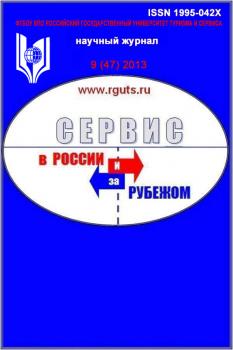Moscow, Russian Federation
The article presents a statistical approach to the service management. This approach is based on the use of the exponential probability distribution in service models and is demonstrated on the examples of multifunctional service centers. The authors offer a method for setting the maximum limit for the waiting time in a queue to be served, which is interpreted in statistical terms as the failsafe (by level) quantile of waiting time. Given the average waiting time, a formula for specifying the maximum limit for the waiting time considering an allowable percentage of customers, who will have to wait longer than the maximum waiting time, is given. The formula reads as follows: the maximum limit for the waiting time is equal to the average waiting time multiplied by the modulus of natural logarithms of the failure level F, where F is equal to the anticipated share of customers who will have to wait longer than the time set by the manager as the maximum waiting time or, in other words, F⋅⋅ 100% is the percentage of failures. For advertising the efficiency, the manager is interested in setting the minimum allowable maximum waiting time; this time corresponds to a maximum allowable failure level F. Software for computing the maximum limit for the waiting time is offered. As a byproduct, an interesting result is obtained: In any queue, 37% of customers wait longer than the average waiting time to be served while 39% of customers wait shorter than half of the average waiting time. In summary, the main time-related quality indicator of service is the average waiting time in a queue. This indicator is equal to the ratio of two characteristics: the maximum limit for the waiting time / the absolute value of the natural logarithm of the share of failures in the total number of customers, that is, the proportion of customers who will have to wait longer than the time declared as the maximum waiting time.
quality management, queuing theory, waiting time, exponential distribution, multifunctional public services centers
1. Brown L., Gans N., Mandelbaum A., Sakov A., Shen H., Zeltyn S., Zhao L. Statistical analysis of a telephone call center: A queueing-science perspective // J. Amer. Stat. Assoc. 2005. V. 100. No. 469. P. 36-50. DOIhttps://doi.org/10.1198/016214504000001808.
2. Ventsel E.S. Probability Theory. 6th Edition. Moscow: Vys. Shkola, 1999. 576 p.
3. Kozlova O.A., Gladkova T.V., Makarova M.N., Tukhtarova Ye.Kh. Methodical approach to measuring the life quality in region. // Economy of Region. 2015. No. 2 (42). P. 182-193. DOIhttps://doi.org/10.17059/2015-2-15.
4. Lawrencenko S., Duborkina I.A. Search algorithms for efficient logistics chains. Preprint deposited at arXiv http://arxiv.org/ (Cornell University Library). 09 April 2015. No. arXiv:1504.03170. - URL: http://arxiv.org/ftp/arxiv/papers/1504/1504.03170.pdf (Accessed on September 13, 2016).
5. Lawrencenko S.A., Duborkina I.A. Search algorithms for efficient logistics chains in service process networks// Service in Russia and Abroad. 2015. V. 9. No. 2 (58). P. 37-48. DOIhttps://doi.org/10.12737/11889. URL: http://electronic-journal.rguts.ru/index.php?do=cat&;category=2015_2 (Accessed on September 13, 2016). Accessed on: 13.09.2016.
6. Levine D.M., Stephan D., Krehbiel T.C., Berenson M.L. Statistics for Managers Using Microsoft Excel. 5th Edition. Upper Saddle River, NJ: Prentice Hall, 2008.
7. Lisovskaya E., Moiseeva S. Study of the Queuing Systems M|GI|N|?. Information Technologies and Mathematical Modelling - Queueing Theory and Applications / 14th International Scientific Conference, ITMM 2015, named after A. F. Terpugov, Anzhero-Sudzhensk, Russia, November 18-22, 2015, Proceedings / Communications in Computer and Information Science. V. 564. P. 175-184 / Eds. A. Dudin, A. Nazarov, R. Yakupov. - Basel: Springer, 2015. - 433 p. ISBN 978-3-319-25860-7. URL: http://link.springer.com/chapter/10.1007/978-3-319-25861-4_15 (Accessed on September 13, 2016).
8. Lontay Z., P?l А., Bakoss G., Werring L. Regulatory Implications of Energy Efficiency Policies: INOGATE Textbook. European Union: ERRA, 2011. 72 p. URL: http://www.inogate.org/documents/EE%20Textbook%20_FINAL_eng.pdf (Accessed on September 13, 2016).
9. Montgomery D.C. Introduction to Statistical Quality Control. 7th Edition. Hoboken, NJ, USA: Wiley, 2013. 766 p. ISBN 978-1-118-14681-1.
10. Nazarov A., Terpugov A.F.: Queueing Theory.2nd Edition. Tomsk: Publishing House of the NTL, 2010. 228 p. ISBN 5-89503-233-8.
11. Platonova N., Vapnyarskaya O. Methods of conducting a service audit at the regional level. // Servis plus. 2016. V. 10. No. 1. P. 3-15. DOIhttps://doi.org/10.12737/17476.
12. Rodr?guez G. Survival models// Quantile. 2008. No. 5. P. 1-27. URL: http://quantile.ru/05/05-GR.pdf (Accessed on September 13, 2016).
13. Rosenberg W.J., Prokhorov A.I., Chto Takoe Teoriya Massovogo Obsluzhivaniya (What Is Queueing Theory?). Moscow: Ripol Classic, 2013. 262 p. ISBN 9785458358200.
14. Sahakyan G.R. Queueing Theory: Lectures. Shakhty: South-Russian State University of Economics and Service, 2006. 27 p.URL: http://window.edu.ru/resource/124/47124/files/sssu068.pdf (Accessed on September 13, 2016).
15. Stewart J. Calculus. - 8th Edition. - Pacific Grove, California, USA: Brooks Cole, 2015. ISBN 9781305271760.





